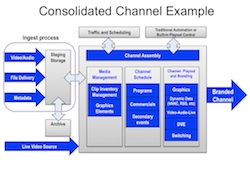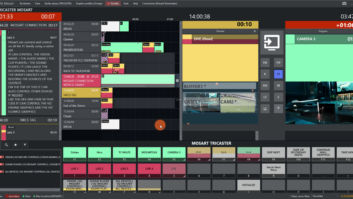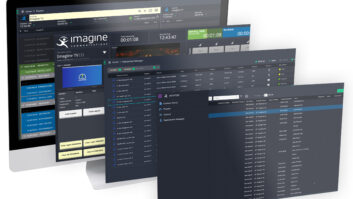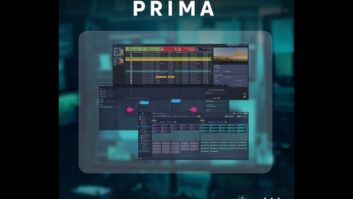
Broadcasters and other television content originators are under unprecedented pressure to reduce the cost of delivering their content. Poor economic conditions in many regions have reduced advertising revenue, squeezing budgets, writes Mark Cousins, product line manager for Omneon (now part of Harmonic).
And the explosive growth of both traditional and alternative content delivery mechanisms has increased the demand for channels and programming. In this environment, “do more with less” has become more than a goal; it is a business imperative.
Thus, content providers continue to show strong interest in approaches that consolidate or ‘collapse’ channel playout functions as much as possible. Their primary motivation is, of course, to reduce the deployment (capital) and operational costs for a playout channel without compromising on presentation quality or channel reliability.
Such cost reductions are realised in several ways:
- The cost of the consolidated system is lower than the cost of the individual components
- The consolidated system occupies less space, consumes less electricity, and needs less cooling
- The workflow to support the consolidated system can be simplified
- The simpler management of the consolidated approach requires less staff
Consolidation: lower costs, simpler operations
A consolidated playout system can be made available at a lower price primarily because it uses a single (or small number of) hardware unit(s) to perform required functions. For a single channel, these functions might include programme playout, format conversion, aspect ratio control, branding, graphics, mixing, and audio processing. The traditional approach might use a separate unit for each of these functions, but a well-engineered consolidated system can perform all of these tasks – to some degree, at least – in a single functional unit.
Of course, the details will vary from one implementation to the next. Some systems may offer all required functionality in one unit but only support one channel. Others may deliver functionality using several units and support multiple channels simultaneously. The system may offer local storage for the playout material and graphics, or it may connect to a shared storage topology.
By their very nature, consolidated systems typically occupy far less equipment rack space than component-based approaches. The reduced component count usually results in far lower power consumption, and this translates to reduced cooling requirements. Costs for equipment room space and the electricity to power and cool gear are significant, but they can be reduced easily through use of a consolidated system.
The workflow supporting consolidated systems can be simpler than workflow supporting component-based systems, primarily because all elements needed for playout — video, audio, branding (logos), graphics, schedules, and so on — are staged at a single location. Systems with internal media management driven by traffic schedules can be configured to retrieve all playout elements automatically. The best, most flexible systems can respond to late changes in the schedule, grabbing the content required and even starting playout before the material is fully transferred.
Such traffic-driven operation further simplifies the workflow by automating playlist creation. The traffic department forwards the schedule for both programming and graphics, and the system takes care of generating main and secondary event playlists. Well-designed systems will alert the operator if material is missing, and if the problem is not rectified by the time the event rolls, the system will choose material from a previously provisioned ‘evergreen’ pool in order to avoid going black-to-air.
This high degree of automation simplifies not only workflows, but overall operations as well, reducing the need for human intervention in controlling and monitoring channels.
When consolidation makes sense
Not all channels lend themselves to consolidation, but many do. Ideal applications include specialty channels that don’t share a lot of material with other channels, disaster recovery (DR) provisioning, and service provider models in which clients need rapid deployment at low cost but don’t require large numbers of channels managed as a group. Poor candidates for consolidation include channels with high-end graphics or branding requirements, channels with unpredictable mixes of live and recorded content, and channels whose schedules change late or frequently.
Simplicity and reduced costs do come at the price of reduced flexibility. Traditional ‘best-of-breed’ solutions allow the broadcaster to choose the components that best solve the problem at hand. Consolidation, on the other hand, is an all-or-nothing proposition: the customer must accept the vendor’s choice of playout, file formats, graphics, interfaces, and (sometimes) automation. Multichannel originators probably find this too limiting for their general operations, but they may see value in consolidation for DR or incremental channel deployments.
Related to but different from consolidated systems are home-grown solutions built on standard IT server and storage components that are mated with commercially available baseband interfaces such as those from AJA, Matrox, Sony, and other vendors. While these systems are very tempting from a cost perspective, they generally require the customer to play the role of systems integrator. In assessing such systems, vendors of broadcast playout systems will rightly suggest that the engineering of a video server consists of far more work than simply bolting together off-the-shelf components.
The requirements for deterministic, realtime performance combined with reliable operation even in degraded situations (such as failed storage modules), as well as support for industry standards (file interchange, control, etc), pose significant engineering challenges that vendors of this equipment have spent dozens of years addressing. It should also be noted that these vendors offer world-class service and support with same-day parts dispatch. By contrast, IT-type systems are supported by their vendors only at the component level, leaving the customer to perform first-level triage and diagnosis.
There is no single right solution for every situation, but these alternative playout systems can offer significant benefits for the right user. Deployment cost is but a single driver in making this decision and should be kept in perspective. Additional considerations should include factors such as ongoing management, feature sets, maintenance, service and support, workflow integration, and interoperability with existing infrastructure. That said, the consolidation story can be very compelling in many circumstances, and it will be interesting to watch how these solutions evolve over the next few years.







